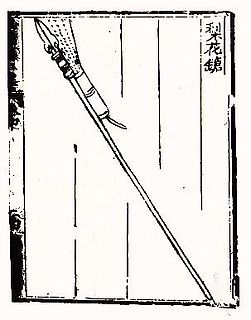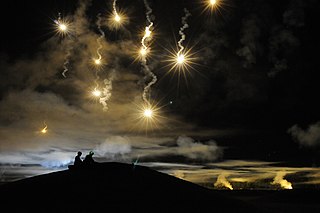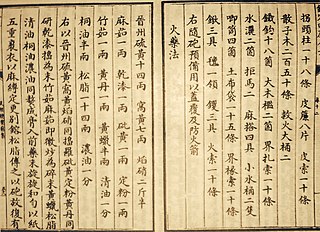 W
WThe military history of the Song dynasty encompasses military activity of the Han Chinese state of Song from 960 AD with the overthrow of Later Zhou until 1279 AD when China was conquered by the Mongol-led Yuan dynasty.
 W
WThe Fierce-fire Oil Cabinet was a double-piston pump naphtha flamethrower first recorded to have been used in 919 AD in China, during the Five Dynasties and Ten Kingdoms period.
 W
WThe fire lance was a gunpowder weapon and the ancestor of modern firearms. It first appeared in 10-12th century China and was used to great effect during the Jin-Song Wars. It began as a small pyrotechnic device attached to a polearm weapon, used to gain a shock advantage at the start of a melee. As gunpowder improved, the explosive discharge was increased, and debris or pellets added, giving it some of the effects of a combination modern flamethrower and shotgun, but with a very short range, and only one shot. By the late 13th century, fire lance barrels had transitioned to metal material to better withstand the explosive blast, and the lance-point was discarded in favor of relying solely on the gunpowder blast. These became the first hand cannons.
 W
WA flare, also sometimes called a fusée, is a type of pyrotechnic that produces a bright light or intense heat without an explosion. Flares are used for distress signaling, illumination, or defensive countermeasures in civilian and military applications. Flares may be ground pyrotechnics, projectile pyrotechnics, or parachute-suspended to provide maximum illumination time over a large area. Projectile pyrotechnics may be dropped from aircraft, fired from rocket or artillery, or deployed by flare guns or handheld percussive tubes.
 W
WGunpowder weapons in the Song dynasty included fire arrows, gunpowder lit flamethrowers, soft shell bombs, hard shell iron bombs, fire lances, and possibly early cannons known as "eruptors". The eruptors, such as the "multiple bullets magazine eruptors", consisting of a tube of bronze or cast iron that was filled with about 100 lead balls, and the "flying-cloud thunderclap eruptor", were early cast-iron proto-cannons that did not include single shots that occluded the barrel. The use of proto-cannon, and other gunpowder weapons, enabled the Song dynasty to ward off its generally militarily superior enemies—the Khitan led Liao, Tangut led Western Xia, and Jurchen led Jin—until its final collapse under the onslaught of the Mongol forces of Kublai Khan and his Yuan dynasty in the late 13th century.
 W
WHu dun pao (虎蹲砲) is the name of two different missile weapons in Chinese history. In the Song dynasty (960–1279), it was a trebuchet and its name is translated into English as Crouching Tiger Trebuchet; in the Ming dynasty (1368–1644), the name was given to a type of bombard and it is known in English as Crouching Tiger Cannon.
 W
WA multiple rocket launcher (MRL) or multiple launch rocket system (MLRS) is a type of rocket artillery system that contains multiple launchers which assembled onto a same platform, and shoots its rocket ordnance in a fashion similar to a volley gun. Rockets are self-propelled in flight and have different capabilities than conventional artillery shells, such as longer effective range, lower recoil, typically considerably higher payload than a similarly sized gun artillery platform, or even carrying multiple warheads.
 W
WThe Song dynasty invented some technological advances in Chinese history, many of which came from talented statesmen drafted by the government through imperial examinations.
 W
WThe Wujing Zongyao, sometimes rendered in English as the Complete Essentials for the Military Classics, is a Chinese military compendium written from around 1040 to 1044.
 W
WThe Wuying Pagoda, also known as the Xingfu Temple Pagoda and The Thousand Year-old Pagoda of Wuhan, is a Buddhist pagoda in Wuchang, Wuhan, Hubei Province, China. Built of stone 750 years ago during the final years of the Southern Song Dynasty, it is the oldest standing architectural feature in Wuhan. Wuying Pagoda is a Major Historical and Cultural Site Protected at the National Level.